IPL has revolutionized Indian television broadcasting. It has redefined the consumption of sports, changed the standards for quality production, viewership, and how advertisements run. Since the first season of IPL in 2008, it has captured the imagination of millions of cricket-lovers and transformed the television medium into an important constituent part of entertainment in India.
One of the major impacts on IPL and television broadcasting is the rapid viewership increase. The league, with its fast-moving matches and more star-studded line-ups, appeals to a wide audience: cricket aficionados and mere followers alike. This has brought forth massive television ratings breaks that propel it right to the top of the most-watched sporting events in India today. The boom has consequently been capitalized by the broadcasters who have invested heavily in the quality of production to be able to produce a view that is stylish and engrossing of this cricket spectacle. Innovations like multi-camera angles, slow-motion replays, and authenticated player statistics have become commonplace features of IPL broadcasts and thus increase excitement for the viewer at home.
The Indian Premier League has also altered the advertising strategies in television broadcasting. Since it reaches an impressive audience, the league has attracted a large number of sponsors who wish to reach an extensive, diversified audience base. The ad spots in IPL matches are in great demand and charge a premium. Brands leverage this popularity of this league to launch new products and encourage services by involving consumers in innovative ways. Introduction of brand integrations wherein adverts are woven into the broadcast further limits the content from advertising. This method does not only catch the attention of viewers but also connects brand recall, thus making IPL broadcasts a goldmine for marketers.
The IPL has further made commentators and analysts a greater integral part of sports broadcasting. That mix of veterans in cricketing history, media personalities, and fresh voices has made the commentary group very vibrant. Diversity always helps discuss things in interesting ways and with different perspectives, which makes for more enjoyable broadcasts. Analysts often elaborate on strategy, a player’s performance, and circumstances in the match for further insightful enlightenment. Entertainment beside technical analysis, has made IPL broadcasts appealing to a wider audient, including the younger section of viewers who would never be interested in the game of cricket previously.
The social media has played a very important role in up-gradation of the television experience during the IPL. The real-time social media updates, viewer poll, and many other interactive features along with the broadcasts made it more interesting for its viewers. Forums have given the viewer the right to participate in discussions, share their thoughts, and even influence certain features of the match-day experience through social media, such as Twitter and Instagram. Interactivity has deepened their ties to the league, and viewers feel more like participants than just witnesses.
Globalization has also enabled the IPL to reach the rest of the world that enjoys broadcast of this sport. Various international networks have brought out contracts to broadcast IPL matches, thus reaching different time and cultures. Globalizing the league made it become even more influential not only to the Indian subcontinent but also the world. The IPL has become a name synonymous with cricket worldwide.
All things considered, IPL has done a very good job in revolutionizing Indian television broadcasting. Be it viewing audience, commercializing advertisements, commentaries, or engagement of the audience, IPL has set new standards. And it is sure to be a path-breaker in the business of sports broadcasting and marketing as it advances.


